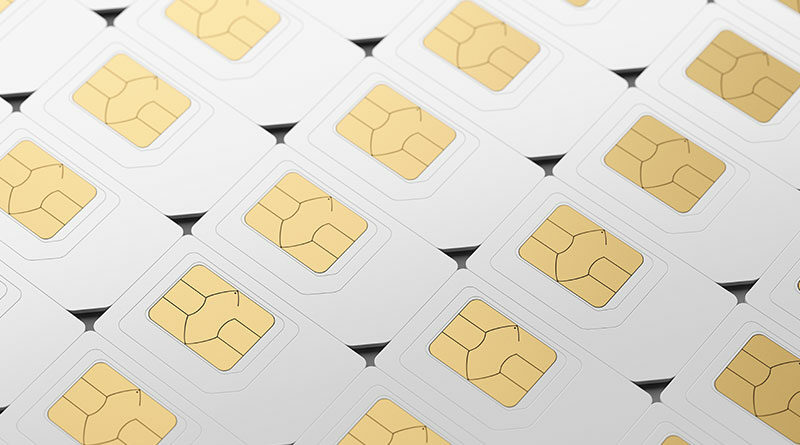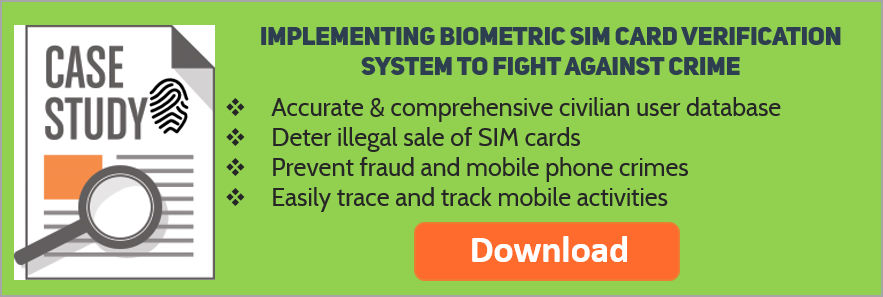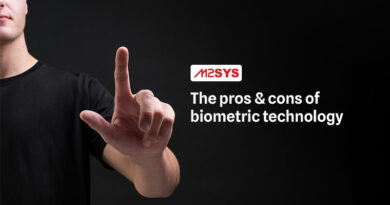Biometric SIM Verification to Fight Against Crime
Biometric subscriber identity module (SIM) verification has gained rapid momentum recently due to the widespread adoption of mobile phones. It is defined as the process of verifying the personal details of a subscriber by utilizing their biometric attributes. The practice of using biometrics for SIM card verification not only works as a proof of ownership credential, but it also creates a sense of accountability among SIM card owners to not use their mobile phones in any kind of criminal activities.
Why use biometrics for SIM card verification?
One might ask why biometric technology is needed for SIM card verification. Biometric technology is one of the most innovative and accurate technologies for individual identification. Due to the fact that biometric traits are unique and cannot be forged, the technology eliminates the possibility of identity theft. Additionally, biometric technology identifies a person based on their biometric traits, so you do not need to carry around a card or registration paper or worry about losing it. This advantage makes biometric technology a convenient and secure way of identifying a person.
Biometric SIM verification to fight crime
Biometric SIM card verification is important in many ways. However, the most important goal of using biometrics for SIM card registration is the reduction of mobile phone related crime such as money laundering, cyber terrorism, and prank calls. As more and more telecommunication authorities are adopting the use of biometrics, it is becoming a useful tool for crime solving in many countries. For example right after The Nigerian Communication Commission (NCC) adopted biometric SIM card verification project, it helped the case of Cynthia Osokogu, the daughter of retired Major General Osokogu, who was murdered in a hotel in Festac Town, Lagos. The police used biometric SIM card verification to identify the suspects and they had no choice but to confess their crime.
Additional Usages
In addition, biometric technology backed SIM card verification enables governments to monitor and verify teledensity figures and active lines in the industry. This ensures that tax revenue from mobile services correlates with data presented by the mobile phone operators.
Who’s using it?
 Many countries around the globe are adopting biometrics for SIM card verification in order to strengthen their national security, crime control, and efficient monitoring of mobile phone operators. Let’s take a look at two of the most successful biometric SIM card registration projects:
Many countries around the globe are adopting biometrics for SIM card verification in order to strengthen their national security, crime control, and efficient monitoring of mobile phone operators. Let’s take a look at two of the most successful biometric SIM card registration projects:
Nigerian Communication Commission (NCC): When the NCC was planning to start biometric SIM card verification exercises in March 2011, not many Nigerians knew why. After the implementation, several crimes carried out by the police were discovered through registered SIM cards. The NCC has paid just over N1.7 Billion to seven vendors involved in the Project, which has registered 11 million SIM cards in the country to date.
Pakistan Telecommunication Authority (PTA): The PTA has authenticated 75.5 million SIM cards through biometric verification under a plan to stop their use in recent terrorist attacks triggered by mobile phones. Out of a targeted 103 million active SIM cards, only 75.5 million SIMs have been reverified. Almost 27.5 million active SIMs have been blocked due the absence of authorized information about them.
Conclusion
Frequent illegal use of mobile networks in criminal activities has caused government authorities to look for more secure ways of monitoring them. Biometric technology has proven to be the most efficient and convenient way of monitoring SIM card usage. Many countries have already realized this and started following the footsteps of Nigeria and Pakistan to reduce criminal activities with biometric SIM card registrations.














since many vendors have their proprietary SDKs, HOW DO WE HARMONISE THEIR DATABASES?
That’s an interesting question but unfortunately because of competition in the marketplace, we doubt that you will see any progress on this in the near future.